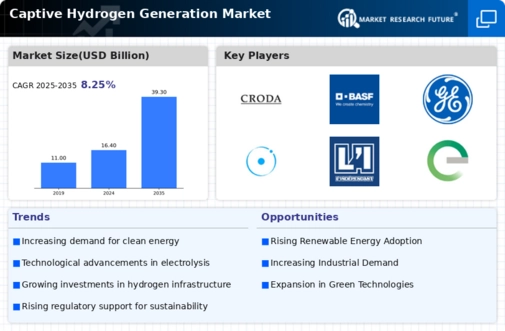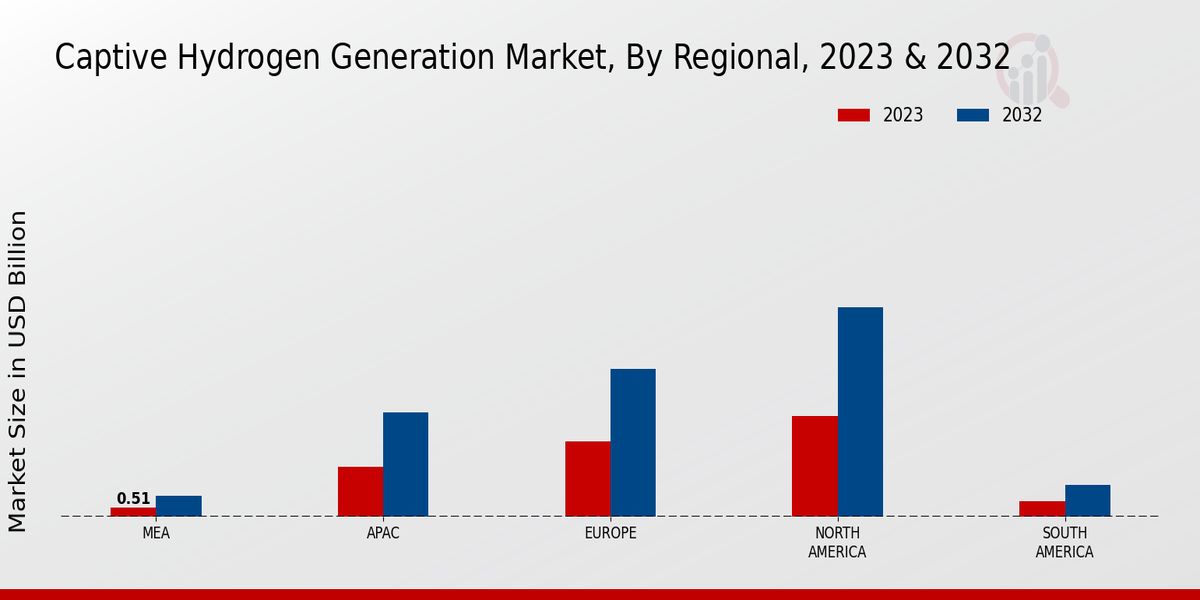Market Growth Projections
The Global Captive Hydrogen Generation Market Industry is projected to experience substantial growth over the next decade. With a market value of 16.4 USD Billion in 2024, it is anticipated to reach 39.3 USD Billion by 2035, reflecting a robust CAGR of 8.25% from 2025 to 2035. This growth trajectory is underpinned by various factors, including increasing demand for clean energy, technological advancements, and expanding industrial applications. The market's expansion is indicative of a broader shift towards sustainable energy solutions, positioning hydrogen as a key player in the global energy landscape.
Rising Demand for Clean Energy
The Global Captive Hydrogen Generation Market Industry is experiencing a surge in demand for clean energy solutions. Governments worldwide are implementing stringent regulations to reduce carbon emissions, pushing industries to adopt hydrogen as a cleaner alternative to fossil fuels. For instance, the European Union has set ambitious targets for hydrogen production, aiming for 10 million tons of renewable hydrogen by 2030. This regulatory environment is likely to drive investments in captive hydrogen generation technologies, contributing to the market's projected growth from 16.4 USD Billion in 2024 to 39.3 USD Billion by 2035, with a CAGR of 8.25% from 2025 to 2035.
Industrial Applications and Demand
The Global Captive Hydrogen Generation Market Industry is witnessing heightened interest from various industrial sectors, including chemicals, refining, and steel production. Hydrogen is a critical feedstock in the production of ammonia and methanol, which are essential for fertilizers and chemicals. Moreover, the steel industry is increasingly exploring hydrogen as a reducing agent, aiming to lower carbon emissions in steelmaking processes. This growing industrial demand is expected to drive the establishment of captive hydrogen generation facilities, as companies seek to secure their hydrogen supply chains and reduce reliance on external sources. The market's expansion in this context appears promising.
Investment in Infrastructure Development
Investment in infrastructure development is a crucial factor influencing the Global Captive Hydrogen Generation Market Industry. Governments and private entities are increasingly recognizing the need for robust hydrogen infrastructure to support production, storage, and distribution. Initiatives such as the Hydrogen Roadmap in various countries aim to create a comprehensive framework for hydrogen deployment. This investment is likely to facilitate the establishment of captive hydrogen generation facilities, enabling industries to produce hydrogen on-site and reduce transportation costs. As infrastructure improves, the market is expected to gain momentum, fostering a conducive environment for growth.
Integration with Renewable Energy Sources
The integration of captive hydrogen generation with renewable energy sources is a pivotal driver for the Global Captive Hydrogen Generation Market Industry. As countries strive to transition to sustainable energy systems, hydrogen is increasingly viewed as a means to store and transport renewable energy. For instance, excess electricity generated from wind and solar can be converted into hydrogen through electrolysis, providing a viable solution for energy storage. This synergy not only enhances energy security but also supports the decarbonization of various sectors. The growing emphasis on renewable energy integration is likely to bolster the market's growth, as industries seek to leverage hydrogen's versatility.
Technological Advancements in Hydrogen Production
Innovations in hydrogen production technologies are propelling the Global Captive Hydrogen Generation Market Industry forward. Advances in electrolysis, steam methane reforming, and biomass gasification are enhancing efficiency and reducing costs. For example, new electrolyzer technologies are achieving higher efficiencies, which could lower the cost of green hydrogen production significantly. As these technologies mature, they are expected to attract more investments and facilitate the establishment of captive hydrogen generation facilities across various sectors, including transportation and manufacturing. This trend aligns with the industry's growth trajectory, as the market is anticipated to expand substantially over the next decade.
























